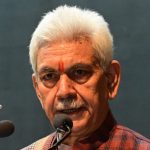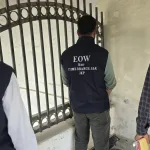There was a time when Kashmir’s summers arrived like a quiet blessing. The snow on the mountain slopes melted gently into streams, the meadows bloomed with iris and daisies, and the winds whispered through the chinars with a soothing coolness that seemed to come from some ancient blessing.
Tourists flocked to Pahalgam and Gulmarg not to escape the heat, but to meet the kind of serene summer that felt like a benediction. Locals moved about in pherans even in June evenings. Houses were built to invite the breeze, and windows remained open without fear of heat or dust. But somewhere along the way, the seasons forgot their rhythm. The snows retreated early, the sun grew fierce, and the valley that once knew moderation in all things began to feel the scorch of something alien: a new, unforgiving summer.
The recent and consistent rise in temperature across Kashmir has come as a rude awakening to a people who once believed they lived in a climatically privileged paradise. But this rise is not a seasonal whim; it is a consequence of a larger, more ominous reality—climate change. Kashmir is now warming faster than the national average, and while the signs are subtle to the untrained eye, they are unmistakably devastating in their collective impact.
The climate of Kashmir, defined for centuries by its balance, now sways under pressures it cannot endure. Spring shortens and rushes into summer. The heat that once crept in like a guest now barges in like an intruder. The changes are not merely about discomfort—they are about survival. Melting glaciers, erratic rainfall, drying springs, forest fires, and heat stress are not fragments of some faraway environmental debate. They are here, and they are altering the face of the valley.
What causes this shift in a land known for its natural equilibrium? The answer lies in a tangled web of global and local factors. At a planetary level, the unchecked emission of greenhouse gases—carbon dioxide, methane, nitrous oxide—has warmed the Earth’s atmosphere, trapping heat that once escaped freely into space. This global warming has triggered a chain reaction: polar ice caps are melting, sea levels are rising, and ecosystems are collapsing under the weight of their own imbalance.
Kashmir, nestled in the lap of the fragile Himalayas, is among the worst-hit by these changes. The region’s glaciers, which feed the Jhelum and sustain agriculture, are melting at a pace far quicker than predicted. With snowlines receding and snowfall becoming erratic, the hydrological cycle that once ensured water security is breaking apart. Traditional water sources like springs and streams are drying up, leaving entire villages without clean drinking water during the summer months.
But the story does not end with melting snow. Over the years, rampant deforestation has stripped the valley of its natural defences. Trees that once absorbed carbon and regulated temperature have fallen to the axe in the name of progress. Wetlands, which acted as climate stabilizers and biodiversity hotspots, have been filled and encroached upon. The famed Hokersar and Wular wetlands—once alive with migratory birds and aquatic life—now stand choked with silt, weeds, and urban waste.
Urbanization, unplanned and unchecked, has dealt another blow. Srinagar, the summer capital, has morphed into a concrete sprawl. Open spaces have been sacrificed to greed, and lakeside promenades are now clogged with vehicles and exhaust. Buildings rise tall but without climate sensitivity, absorbing heat and radiating it back into already warming neighbourhoods. Asphalt replaces grass, glass replaces wood, and air conditioners replace trees. With every square metre of concrete, the valley grows a little hotter.
Culturally too, Kashmiris are drifting from their harmonious relationship with nature. Traditional homes built with mud, wood, and stone—natural insulators against both heat and cold—are giving way to modern architecture that ignores the ecological wisdom of generations. The use of plastic, an almost alien concept in traditional Kashmiri households, now chokes drains and rivers alike. Rivers once revered have become dumping grounds. Rituals once tied to the seasons now struggle to find context in a disordered calendar.
Agriculture, the lifeblood of rural Kashmir, is perhaps the most direct victim. Apple orchards are blooming earlier than expected, leading to mismatches in pollination. Walnut and cherry crops are seeing unusual diseases, and rice paddies suffer from delayed monsoons or untimely hailstorms. Farmers, already grappling with economic challenges, now face a cruel uncertainty—will the crops survive the summer heat, will there be water to irrigate them, and will the seasons honour their ancient pact with the land?
Amid this chaos, the silent screams of Kashmir’s biodiversity are drowned out. The Himalayan brown bear, the snow leopard, the hangul deer—all symbols of the valley’s wild soul—are now endangered not just by poaching but by climate-induced habitat loss. Forest fires, once rare in Kashmir, are now becoming seasonal scourges. In 2024 alone, nearly 500 hectares of forest land were reported to be engulfed in flames, the smoke blotting out the sun like a mournful omen.
But what can be done when the very earth seems to protest under our feet?
First, there must be a collective recognition that climate change is not a foreign concern—it is an urgent, local crisis. The valley needs a climate vision that is both scientific and spiritual, rooted in data but also in the deep emotional connection Kashmiris share with their land. Awareness campaigns must go beyond token gestures. Schools must include climate literacy as a core part of education. Mosques, shrines, and community halls can become spaces for ecological sermons—lessons in stewardship as sacred duty.
Policy-makers must act with both haste and humility. Afforestation drives must be aggressive, but also strategic—planting native species in areas that were once forested, restoring not just the trees but the ecosystems around them. The wetlands need rescue through desilting, replanting aquatic vegetation, and strict anti-encroachment measures. Urban planning must shift from expansion to sustainability—promoting green buildings, rainwater harvesting, and climate-resilient infrastructure.
Technology can aid the effort. Satellite imagery to monitor forest cover, early-warning systems for floods and fires, and climate-adaptive agricultural tools can be deployed across the valley. Solar energy, long underutilized in Kashmir, must become a mainstream source of power—especially in schools, hospitals, and public buildings.
But beyond policy and science lies a deeper calling—a call to rekindle the lost bond with nature. The elderly in Kashmir still speak of how people would offer the first cup of spring water to the sky in gratitude, how the planting of a tree was an act of devotion, and how every snowfall was greeted not with inconvenience but with reverence. These traditions are not outdated; they are necessary reminders of how to live with the earth, not just on it.
Let the new generation of Kashmiris become climate custodians. Let poetry return to the meadows and science walk beside the shepherd. Let us replant the chinars, not just as symbols of heritage but as guardians of climate. Let the Jhelum once again carry clean water and not the toxins of modernity. Let the apple trees bloom in rhythm with the seasons, not in panic. Let the snow stay a little longer.
If not, the valley may forget how to wear white in winter and how to breathe in summer. The birds will change their flight paths, the flowers their bloom, and the songs of the people may grow quieter under the drone of heat. But if we act, if we listen to the land’s silent warning, there is hope. The snow may return, the springs may flow again, and Kashmir’s summers may once more become poetry.
In the end, it is not just the climate of Kashmir that hangs in balance—it is the soul of the land, the memory of paradise. Will we allow it to fade into a scorched echo, or will we rise to protect the valley’s gentle breath? The answer, like the climate, is shifting. And the time to act is now.
(Author is RK Columnist and can be reached at: [email protected])








